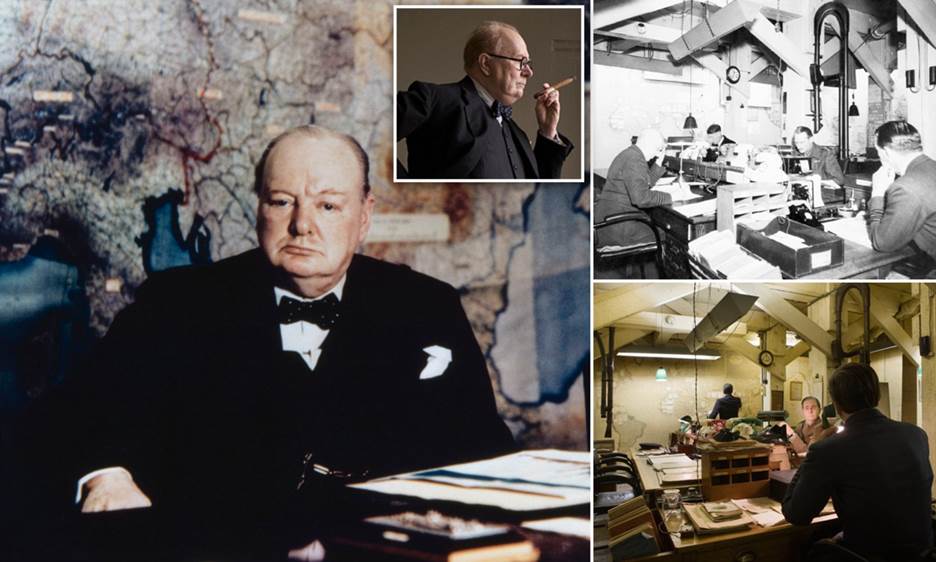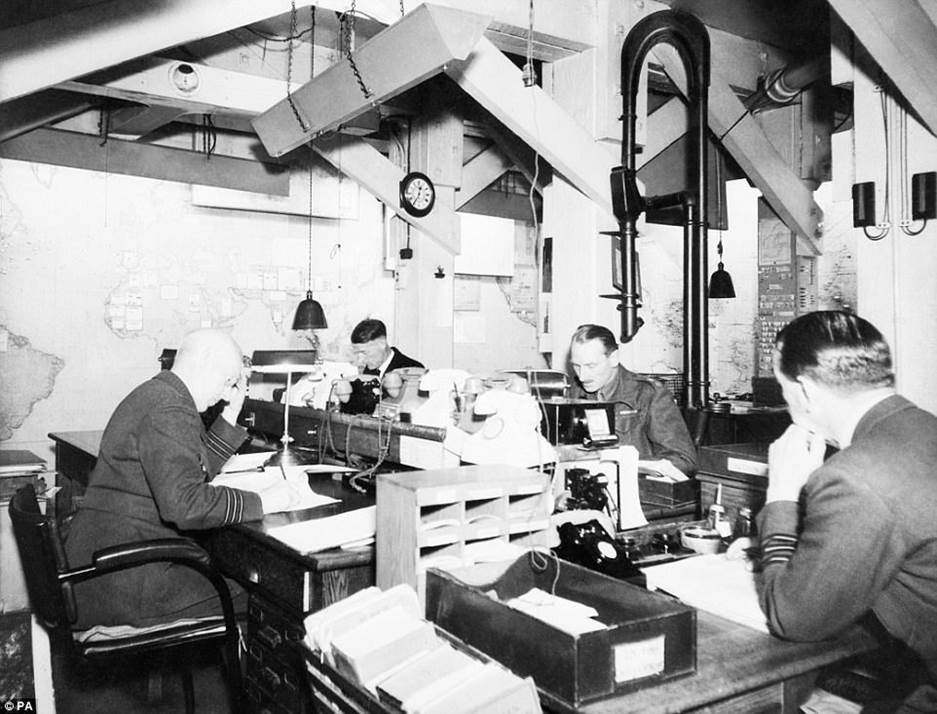
Winston Churchill (pictured while sitting at his desk in the No 10 Annexe Map Room in 1945) had the War Rooms built in 1939 and he walked into the Cabinet Room in 1940 and said: 'This is the room from which I'll direct the war.' The title of the whole underground complex, originally known as the Cabinet War Rooms, was shortened to the Churchill War Rooms in 2010 – Daily Mail Online
The Churchill War Rooms
By Dr Khalid Siddiqui
Ohio

The Churchill War Rooms is a museum located in the London borough of Westminster near the junction of King Charles Street and Horse Guards Road. It is housed in the basement of the Treasury Building.
Statues of Lord Clive and Lord Mountbatten are situated near the entrance. Lord Clive was the British Governor of Bengal Presidency twice in the 18 th century. He committed suicide in 1774. Lord Mountbatten was the last Viceroy and first Governor General of British India. He was killed by the IRA in 1979.
The museum comprises Cabinet War Rooms and the Churchill Museum.
Cabinet War Rooms
In May 1938, the British government ordered the Office of Works to set up a temporary emergency government center. The Office chose the basement of the New Public Offices (now the Treasury Building). Construction of the Cabinet War Rooms began in 1938. The work included the installation of communications and broadcasting equipment, soundproofing, ventilation and reinforcement. World War II was imminent. The War Rooms became operational on 27 August 1939, only days before the invasion of Poland by Germany on 1 September, and Britain's declaration of war on Germany on 3 September.
In 1940, a five-feet thick layer of concrete was added to the roof of the basement. This was to prevent the caving in of the roof from the weight of the rubble in case the building collapsed by air raids. The reinforced bunker/basement included the cabinet room, command center, dormitories for the staff, private bedrooms for military officers and senior ministers, and rooms for typists and telephone switchboard operators. It was a secret underground headquarters where Prime Minister Winston Churchill lived and worked during WWII. The secret tunnels were used by Prime Minister Churchill and his government officers.
The war cabinet met for the first time on October 15, 1940 at 4:58 pm. The clock has been frozen at 4:58. In total, 115 Cabinet meetings were held at the Cabinet War Rooms - the last on 28 March 1945.
The Transatlantic Telephone Room was disguised as Churchill’s private toilet. It had a direct line to the US president. The first conference with President Roosevelt took place on 15 July 1943. The BBC Broadcasting Equipment Room was also located in the basement. Churchill addressed the nation four times from the BBC room – first time on September 11, 1940.
Although Churchill had an office-bedroom in the basement, he rarely slept underground. He either slept at 10 Downing Street or in a flat in the building directly above the Cabinet War Rooms. Other rooms on display are the kitchen, private dining area and switchboard room.
VIDEO OF CHURCHILL'S BEDROOM:
https://drive.google.com/file/d/10yB4knGKXxTtvodmErBwztEALG9tNf26/view?usp=share_link
VIDEO OF CHURCHILL'S KITCHEN:
https://drive.google.com/file/d/1SkCD_5fjeTJ_mqJumNxOJO0Cp7SnQT3q/view?usp=share_link
An actual Enigma machine is on display in one of the rooms. It was used by the German Navy to encode their communications. The Enigma code was eventually deciphered by a team of codebreakers which included Alan Turing, widely considered as the father of computer science. His story is told in the hit film The Imitation Game.
The War Rooms remained in operation throughout WWII, before being abandoned in August 1945 after the surrender of Japan.
The Cabinet War Rooms were opened to the public by Mrs Thatcher on 4 April 1984 in a ceremony attended by Churchill’s family members and former Cabinet War Rooms’ staff.
Churchill Museum
The museum occupies the other section of The Churchill War Rooms. It is a biographical museum exploring the life of Winston Churchill. During 2009–2011 the museum received over 300,000 visitors a year.
Video of Churchill’s High School marching band uniform:
https://drive.google.com/file/d/1C0fVty_f_B8XMuvgS6VCaOk7MhmnWwLu/view?usp=share_link

Four Map Room Officers were photographed working in the Cabinet Room in 1945 and the image is one which was revealed to mark the release of the new film, Darkest Hour. The rooms were later abandoned after Japan's surrender in the summer of 1945 – Daily Mail Online
* Siren Suit: Churchill began to wear these one-piece zip-up suits, which his family called ‘rompers’, during the 1930s. He had made them in a variety of colors and materials. In Britain, people began to copy this Churchillian fashion.
* Churchill Teapot: Churchill had a prominent role in the development of tanks in WWI. Tanks were first used in 1916. A teapot in the shape of a tank was produced to commemorate his role. The teapots were again produced during WWII.
* Smock and artists’ materials: He had a passion for paintings. He took it up more seriously in the later years. He produced over 500 paintings. He preferred to paint in oils. In 1936, while on a holiday in France, he painted ‘The Loup River’ which he successfully entered, under the pseudonym ‘David Winter’, for the 1947 Summer Exhibition at the Royal Academy. His book ‘Painting as a Pastime’ was published in 1948. Churchill experimented with sculpting also but, according to sculptor Oscar Nemon, he found the clay too dirty. In 1953 Churchill was staying in Chartwell, Kent, busy making the cast of the head of Oscar Nemon while Nemon was sculpting Churchill! That is the only sculpture Churchill ever made.
* Churchill was first nominated for the Nobel Prize in Literature in 1946 on the basis of his historic narratives and rhetoric speeches, but his candidacy was rejected. H e was finally awarded the Nobel Prize in Literature in 1953 for his non-fiction work ‘The Second World War’. He was disappointed that he had not been awarded the Nobel Peace Prize.
* Churchill was awarded Honorary US citizenship by President Dwight D. Eisenhower. He was too sick to travel to the USA to accept the award from President John F. Kennedy. His son Randolph Churchill accepted it on his behalf at a ceremony held at the White House in 1963. Although born in 1874, Churchill was still alive when Kennedy was assassinated in November 1963!
* 10 Downing Street: In 1991, the wooden door was replaced with a blast-proof door after an IRA mortar attack on Downing Street. The prime minister does not have keys to the door. Also, the door cannot be opened from the outside. A security guard is always on duty to let people in from the inside. The brass letterbox on the front of the door is purely decorative. There are two doors which are alternated approximately every two years to be repainted.

